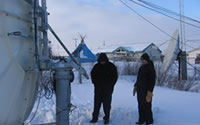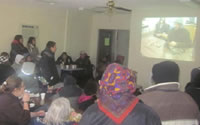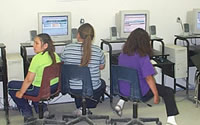Internet and Social Networking
 All the Fort Severn community organizations and services are networked via the local cable network that was upgraded in 2000 when the C-Band data satellite network was established. In 1998 a wireless data network was installed to service the Keewaytinook Internet High School, the band office and the health centre. This original wireless network was established in partnership with Industry Canada’s FedNor and First Nations SchoolNet programs but was later upgraded to the local cable network.
All the Fort Severn community organizations and services are networked via the local cable network that was upgraded in 2000 when the C-Band data satellite network was established. In 1998 a wireless data network was installed to service the Keewaytinook Internet High School, the band office and the health centre. This original wireless network was established in partnership with Industry Canada’s FedNor and First Nations SchoolNet programs but was later upgraded to the local cable network.
Community Internet service
Soon after Fort Severn established its community cable TV service in 1991, all the homes in the community were connected to the cable system. That same cable is used to deliver Internet service to homes today.
Similar to the community television service, many people were involved in establishing the community Internet service. The Chief and council asked community members what they wanted and how the Internet should be delivered. Fort Severn was more fortunate than other First Nation communities that did not have a community cable TV service. Because the cable TV service was in place, the community was able to make decisions about the business model for the Internet service: if they should charge community members and how much they should charge. In the end, they decided to charge community members for the Internet service so they could have revenues to pay for the maintenance and development of the service.
The Fort Severn community Internet service also connects the community hotel, the school, and other community organizations. Residents and others connecting to the service pay a monthly fee to the band office, which manages the service. The funds support the employment of a local technician who also manages the Fort Severn e-Centre.
 Community residents use the Internet for many different reasons, from information searches and email to online banking at convenient hours. Most Fort Severn residents use K-Net Services for their email – their email addresses are in the form of [name@knet.ca]. K-Net is the telecommunications service of the Keewaytinook Okimakinak tribal council.
Community residents use the Internet for many different reasons, from information searches and email to online banking at convenient hours. Most Fort Severn residents use K-Net Services for their email – their email addresses are in the form of [name@knet.ca]. K-Net is the telecommunications service of the Keewaytinook Okimakinak tribal council.
Similar to the community television service, community members see both positive and negative impacts of the community Internet service now and into the future. On the positive side, the Internet allows community members to do many things that were impossible before, including different ways of learning and accessing information and educational resources, creative activities such as making their own music and videos, and developing new small business activities.
 For the community youth, the Internet is seen as offering great potential to learn. However some community members believe that the children should not be using the Internet unsupervised. Having access to inappropriate material through the Internet is considered to be the major negative impact of the Internet for the community youth.
For the community youth, the Internet is seen as offering great potential to learn. However some community members believe that the children should not be using the Internet unsupervised. Having access to inappropriate material through the Internet is considered to be the major negative impact of the Internet for the community youth.
The far reach of the Internet in Fort Severn can be seen when the network is down. Community members have described that when the network is down – for example if there is a problem with the satellite dish – people will walk out of the buildings and wander around, feeling disconnected from the rest of the world.
The amount of bandwidth the community has available for the Internet – practically speaking, how fast the Internet works – is limited to the bandwidth available through the satellite connection. In the future, more bandwidth will be available when other First Nations communities drop off the satellite connection as they hook up to fibre connections.
Internet for delivering community services
Many Fort Severn community services use the Internet extensively. One example is the community policing service, which uses it for time logs, accessing Interpol criminal searches and writing up occurrences and Crown briefs.
To give another example, the Fort Severn band office uses the Internet extensively for many purposes, such as scanning and sending reports, online recording, online bank transfers, payments to individuals and suppliers, and exchanging data and information efficiently with services and organizations outside the community. One thing that remains a challenge is the official Fort Severn website, because currently the band does not have a community volunteer to maintain the site and does not have the funds to pay for someone to do the work.
Finally, staff working with essential community services such as health and education also use the Internet extensively for ongoing activities.
MyKnet.org
 Keewaytinook Okimakinak, Fort Severn's tribal council, set up the MyKnet.org service for social networking among First Nations. MyKnet.org (www.myknet.org) is a service that allows community members to set up and maintain their own websites. Many Fort Severn community members have their own MyKnet.org websites, although with the rise of Facebook, many of their MyKnet.org sites are not being maintained regularly.Nevertheless, some community members regularly read MyKnet.org websites to keep up to date with what other community members are doing.
Keewaytinook Okimakinak, Fort Severn's tribal council, set up the MyKnet.org service for social networking among First Nations. MyKnet.org (www.myknet.org) is a service that allows community members to set up and maintain their own websites. Many Fort Severn community members have their own MyKnet.org websites, although with the rise of Facebook, many of their MyKnet.org sites are not being maintained regularly.Nevertheless, some community members regularly read MyKnet.org websites to keep up to date with what other community members are doing.
Fort Severn community members use Facebook extensively. Some community members say they are “addicted” to Facebook because they are on it so often to see what everyone else is up to. Interestingly however, community members also use Facebook often as part of their jobs and for community work. Some of the personal reasons cited for using Facebook include keeping in touch with friends and family members who are travelling outside the community.
Facebook for community services
 Many staff members of community services organizations use Facebook in their work. A common use for work is using the message system to contact a community member. For example, band council members use Facebook extensively to communicate with each other and set up meetings.
Many staff members of community services organizations use Facebook in their work. A common use for work is using the message system to contact a community member. For example, band council members use Facebook extensively to communicate with each other and set up meetings.
The Fort Severn Junior Rangers organization uses Facebook to let members know what’s going on and to schedule events. They also post photos from previous Junior Ranger events. The youth members use Facebook to keep in touch with Junior Ranger members in other communities.
Some health centre staff use Facebook to remind community members of appointments because they find it easier to reach them that way than by phone or other means. They find that people check their Facebook for messages more often than they check their phone messages.
Other community services using Facebook include youth services such as scheduling and posting notices of sports activities and making announcements such as the winners of broomball tournaments. The Wahsa distance education service uses Facebook to keep students aware of activities and scheduling issues.
